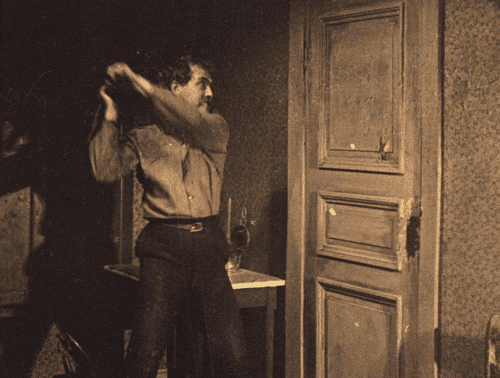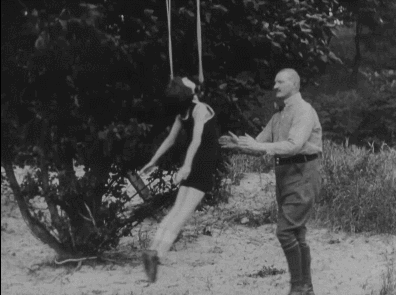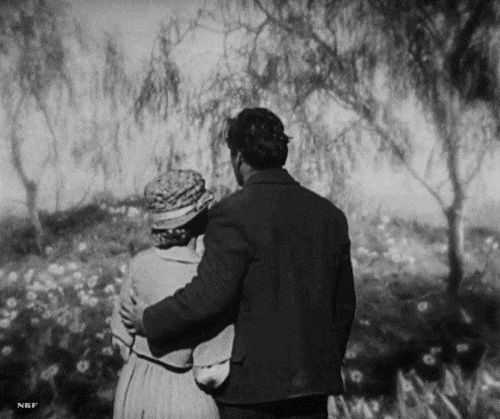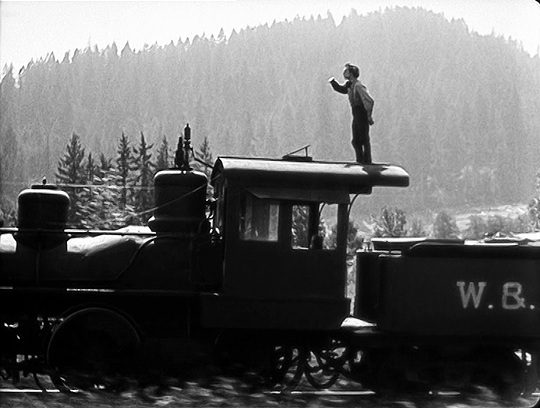“I want to be good, but no one believes me. Is it any wonder I cry?”Körkarlen [The Phantom Carriage] (Victor Sjöström, 1921)
Jun
13
International Axe Throwing Day

David Holm (Victor Sjöström) attempts to break through a wooden door with the butt of an axe. This scene was the inspiration for the infamous door scene in Kubrick's The Shining (1980). DP: Julius Jaenzon.
– David Holm
1920s
“Shoulder to shoulder. The land is ours. Tomorrow is ours.”Броненосец Потёмкин [Bronenosets Potyomkin / Battleship Potemkin] (Sergei Eisenstein, 1925)
Jun
8
Bounty Day

A closeup of a sailor. DPs: Eduard Tisse & Vladimir Popov.
– sailor
“How did God ever put a thing like you on this earth?” West of Zanzibar (Tod Browning, 1928)
May
14
Spinalcord Injury Awareness Day

Lon Chaney as the tormented Phroso dragging himself along the ground. DP: Percy Hilburn.
A brawl over a woman. That's what breaks The Great Phroso. After recovery, a year later, he finds himself a #paraplegic and his stolen wife dead in a church with an infant next to her. To Africa he takes the child – it's the other man's, the ivory trader's – and carefully, vengefully raises her.
– Maizie
Phroso, now known as Dead-Legs and White Voodoo to the tribe he resides over, uses his magician's skills to rule over his own little jungle empire. We see the gestation of Kurtz, oddly too an ivory trader in that other White Hell, Heart of Darkness (Joseph Conrad, 1899).
Despite attempts to tone it down on request of censors, West of Zanzibar is one of Tod Browning's meanest. Lon Chaney is fantastic, of course. His Phroso, torn by love and #revenge, one of the early and rare depictions of male frailty in western cinema.
Аэлита [Aelita / Aelita: Queen of Mars] (Yakov Protazanov, 1924)
Apr
29
International Astronomy Day

Queen Aelita (Yuliya Solntseva) peering through her telescope. DPs: Emil Schünemann & Yuri Zhelyabuzhsky.
Like in Enrico Novelli's Un matrimonio interplanetario [A Marriage in the Moon] (1910), interplanetary romance blooms in Аэлита.
Through her #telescope, Queen Aelita spots engineer Los, a handsome Earth man, and he promptly travels to #Mars to be with her. There, Los uncovers an uprising by the Elders against his beloved queen that he vows to – in good proletarian fashion – stomp down.
Aelita*'s constructivist stage and costume design had an enormous influence on science fiction, as far as the late 20th century.
Wege zu Kraft und Schönheit [Ways to Strength and Beauty] (Wilhelm Prager + Nicholas Kaufmann, 1925)
Apr
18
National Exercise Day

A young woman with a pageboy cut and a black bathing suit is suspended from a tree with the back of her neck. An instructor, a bald man with a moustache and tan jodhpurs, pushes her as if she's on a swing set. DPs: Eugen Herich, Friedrich Paulmann & Friedrich Weinmann.
Europeans are not too worried about certain things. Having a body for instance is something good. Instead of shame, you take care for it with regular exercise and plenty of fresh air. Preferably both. In Germany this is called #Freikörperkultur, sometimes confused with nudism.
Wege zu Kraft und Schönheit is a display of the human in various stages of exercise and undress. We see sportspeople – including future-Tarzan Johnny Weissmuller and then-movie mountaineer Leni Riefenstahl – world leaders (Rockefeller and Mussolini, though the latter was cut from re-releases) and dancers such as Josephine Baker, Baku Ishii, and the scandalous Anita Berber. The film was mostly aimed at women, who by then were part of the workforce, sitting at desks in modern Metropolises. So modern it was that people were encouraged to complete their Wege-collection of trading cards, which came with their cigarettes. Good thing they're all #outdoors.
Paris qui dort [Paris Asleep / The Invisible Ray / At 3:25] (René Clair, 1925)
Mar
30
freebie: Eiffel Tower Day

Two bright young things in their fashionable suits cease their scuffle mid fight, high up on the Eiffel Tower. DPs: Maurice Desfassiaux & Alfred Guichard.
Science fiction may be one of those genres that's forever linked to the future and, depending on which side of 2000 you are at, either in a dystopian of utopian fashion.
An #Eiffel Tower watchman wakes up to find the world around him asleep. The few ones still awake – the bright, pretty, carefree things – explore, live and loot.
“I'm trying to teach you to run it – not wreck it!” Steamboat Bill, Jr. (Charles Reisner + Buster Keaton, 1928)
Mar
23
National Near Miss Day

A production photo showing the moment the façade crashing down towards Keaton. The photographer is standing to the right of Keaton at a very safe distance. The thickness of the wall is clearly, frightfully, visible. Even with the open window moving towards him, this blink-and-you-miss-it shot cannot guarantee a happy ending for Keaton or his movie persona William Canfield Jr. DPs: Bert Haines & Devereaux Jennings.
In Steamboat Bill, Jr., former vaudevillian Keaton narrowly escapes the façade of a house crashing down around him.
– William 'Steamboat Bill' Canfield
Both the man and the stunt lived on, probably most famously in Keaton aficionado #JackieChan's Project A Part II (HK, 1987).
Despite all the well-meant tributes, none of the later stunts are as nail biting as the pre-OSHA original.
“This song of the Man and his Wife is of no place and every place; you might hear it anywhere, at any time.”Sunrise: A Song of Two Humans (F.W. Murnau, 1927)
Mar
12
Academy Award For Best Picture

The Man and Wife kiss in the countryside. Suddenly, the backdrop changes to the hustle and bustle of the big city. Carts, both horse and engine driven, come to a halt for the lovers. DPs: Charles Rosher & Karl Struss.
Sunrise was bestowed the award for “Best Unique and Artistic Picture” on that first Oscar night. The first and last time that ever happened; in 1930, the price was scrapped and replaced by “Outstanding Picture” aka “Best Picture”. And that one went to the much more American-patriotic Wings (1927).
Also rightfully awarded in '29 were Janet Gaynor (Best Actress in a Leading Role), Charles Rosher and Karl Struss (Best #Cinematography), while Rochus Gliese was nominated for Best #ArtDirection.
– opening title card
Sunrise is a fantastic tour de force, and it winning that award should make you feel hopeful for the future of cinema. Instead, the current list of nominees and winners is, at least to me, a checklist of what to avoid for ever.
“This girl was in the baggage car when we stole the train, so I thought it best to hold her.”The General (Clyde Bruckman + Buster Keaton, 1926)
Mar
8
National Oregon Day

Johnnie Gray (Keaton) stands on the roof of The General's locomotive while Oregon passes along. DPs: Bert Haines & Devereaux Jennings.
For authenticity reasons, The General was – for the most part – filmed on location in Oregon. Set during the #AmericanCivilWar, it's a comedic retelling of a popular war memoir about the #GreatLocomotiveChase.
– Captain Anderson
Sadly it was a box office #flop, resulting in Keaton losing his independence and his movie entering the #PublicDomain as early as 1954. Luckily for us that means we too can enjoy Oregon beautiful 1920s vistas.
“I have finally discovered my ancestors' traditional dance.”Sur un air de Charleston [Charleston Parade] (Jean Renoir, 1927)
Feb
14
Extraterrestrial Culture Day

Parisian savage Catherine Hessling and African explorer Johnny Hudgins exploring each other's alien ways. DP: Jean Bachelet.
Legendary African-American #vaudeville performer Johnny Hudgins – in historically correct Blackface – plays an African explorer who descends onto 2028 Paris to learn about the primitive ways of the white natives. Soon, he discovers the Charleston.
– Johnny Hudgins
A fantastic Afrofuturist short, made a decade before Sun Ra's trip to Saturn.